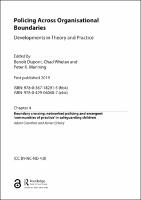Chapter 4 Boundary crossing
networked policing and emergent ‘communities of practice’ in safeguarding children
| dc.contributor.author | Crawford, Adam | |
| dc.contributor.author | L’Hoiry, Xavier | |
| dc.date.accessioned | 2019-10-17 13:50:53 | |
| dc.date.accessioned | 2020-04-01T10:21:32Z | |
| dc.date.available | 2020-04-01T10:21:32Z | |
| dc.date.issued | 2019 | |
| dc.identifier | 1005009 | |
| dc.identifier | OCN: 1135846689 | en_US |
| dc.identifier.uri | http://library.oapen.org/handle/20.500.12657/25085 | |
| dc.description.abstract | Child safeguarding has come to the forefront of public debate in the UK in the aftermath of a series of highly publicised incidents of child sexual exploitation and abuse. These have exposed the inadequacies and failings of inter-organisational relations between police and key partners. While the discourse of policing partnerships is now accepted wisdom, progress has been distinctly hesitant. This paper contributes to understanding both the challenges and opportunities presented through working across organisational boundaries in the context of safeguarding children. It draws on a study of relations within one of the largest Safeguarding Children partnerships in England, developing insights from Etienne Wenger regarding the potential of ‘communities of practice’ that innovate on the basis of everyday learning through ‘boundary work’. We demonstrate how such networked approaches expose the differential power relations and sites of conflict between organisations but also provide possibilities to challenge introspective cultures and foster organisational learning. We argue that crucial in cultivating effective ‘communities of practice’ are: shared commitment and purpose; relations of trust; balanced exchange of information and resources; mutual respect for difference; and an open and mature dialogue over possible conflicts. Boundary crossing can open opportunities to foster increased reflexivity among policing professionals, prompting critical self-reflection on values, ongoing reassessment of assumptions and questioning of terminology. Yet, there is an inherent tension in that the learning and innovative potential afforded by emergent ‘communities of practice’ derives from the coexistence and interplay between both the depth of knowledge within practices and active boundaries across practices. | |
| dc.language | English | |
| dc.subject.classification | thema EDItEUR::J Society and Social Sciences::JK Social services and welfare, criminology::JKS Social welfare and social services | en_US |
| dc.subject.other | Child safeguarding | |
| dc.subject.other | organisational bounderies | |
| dc.title | Chapter 4 Boundary crossing | |
| dc.title.alternative | networked policing and emergent ‘communities of practice’ in safeguarding children | |
| dc.type | chapter | |
| oapen.relation.isPublishedBy | 7b3c7b10-5b1e-40b3-860e-c6dd5197f0bb | |
| oapen.relation.isPartOfBook | b4d60267-d1c7-482d-b54b-fd53c00c5247 | |
| oapen.relation.isbn | 9780429060687 | |
| oapen.imprint | Routledge | |
| oapen.pages | 20 | |
| oapen.remark.public | 3-8-2020 - No DOI registered in CrossRef for ISBN 9780367182915 | |
| oapen.identifier.ocn | 1135846689 | |
| peerreview.anonymity | Single-anonymised | |
| peerreview.id | bc80075c-96cc-4740-a9f3-a234bc2598f1 | |
| peerreview.open.review | No | |
| peerreview.publish.responsibility | Publisher | |
| peerreview.review.stage | Pre-publication | |
| peerreview.review.type | Proposal | |
| peerreview.reviewer.type | Internal editor | |
| peerreview.reviewer.type | External peer reviewer | |
| peerreview.title | Proposal review | |
| oapen.review.comments | Taylor & Francis open access titles are reviewed as a minimum at proposal stage by at least two external peer reviewers and an internal editor (additional reviews may be sought and additional content reviewed as required). |

